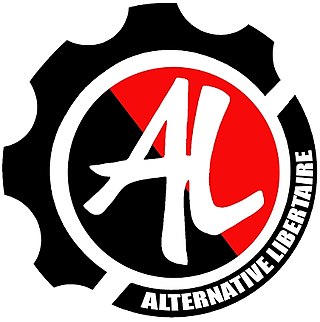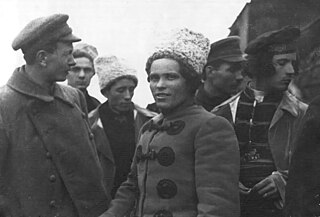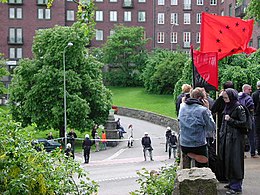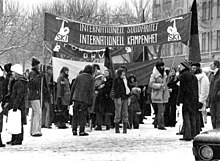
Syndicalism is a revolutionary current within the labour movement that, through industrial unionism, seeks to unionize workers according to industry and advance their demands through strikes, with the eventual goal of gaining control over the means of production and the economy at large through social ownership. Developed in French labor unions during the late 19th century, syndicalist movements were most predominant amongst the socialist movement during the interwar period that preceded the outbreak of World War II.
Anarcho-syndicalism is a political philosophy and anarchist school of thought that views revolutionary industrial unionism or syndicalism as a method for workers in capitalist society to gain control of an economy and thus control influence in broader society. The goal of syndicalism is to abolish the wage system, regarding it as wage slavery. Anarcho-syndicalist theory generally focuses on the labour movement. Reflecting the anarchist philosophy from which it draws its primary inspiration, anarcho-syndicalism is centred on the idea that power corrupts and that any hierarchy that cannot be ethically justified must be dismantled.
The International Workers' Association – Asociación Internacional de los Trabajadores (IWA–AIT) is an international federation of anarcho-syndicalist labor unions and initiatives.
According to different scholars, the history of anarchism either goes back to ancient and prehistoric ideologies and social structures, or begins in the 19th century as a formal movement. As scholars and anarchist philosophers have held a range of views on what anarchism means, it is difficult to outline its history unambiguously. Some feel anarchism is a distinct, well-defined movement stemming from 19th-century class conflict, while others identify anarchist traits long before the earliest civilisations existed.
Anarchist economics is the set of theories and practices of economic activity within the political philosophy of anarchism. Anarchists are anti-authoritarian and anti-capitalist, with anarchism usually referred to as a form of libertarian socialism, i.e. a stateless system of socialism. Anarchists support personal property and oppose capital concentration, interest, monopoly, private ownership of productive property such as the means of production, profit, rent, usury and wage slavery which are viewed as inherent to capitalism.

The Zabalaza Anarchist Communist Front, formerly known as the Zabalaza Anarchist Communist Federation (ZabFed), is a platformist–especifista anarchist political organisation in South Africa, based primarily in Johannesburg. The word zabalaza means "struggle" or "active rebellion" in isiZulu, isiXhosa, siSwati and isiNdebele. Initially, as ZabFed, it was a federation of pre-existing collectives, mainly in Soweto and Johannesburg. It is now a unitary organisation based on individual applications for membership, describing itself as a "federation of individuals". Historically the majority of members have been people of colour. Initially the ZACF had sections in both South Africa and Swaziland. The two sections were split in 2007, but the Swazi group faltered in 2008. Currently the ZACF also recruits in Zimbabwe. Members have experienced oppression in South Africa and Swaziland.
The Japanese Anarchist Federation was an anarchist organisation that existed in Japan from 1946 to 1968.
Anarchism in South Africa dates to the 1880s, and played a major role in the labour and socialist movements from the turn of the twentieth century through to the 1920s. The early South African anarchist movement was strongly syndicalist. The ascendance of Marxism–Leninism following the Russian Revolution, along with state repression, resulted in most of the movement going over to the Comintern line, with the remainder consigned to irrelevance. There were slight traces of anarchist or revolutionary syndicalist influence in some of the independent left-wing groups which resisted the apartheid government from the 1970s onward, but anarchism and revolutionary syndicalism as a distinct movement only began re-emerging in South Africa in the early 1990s. It remains a minority current in South African politics.

Alternative libertaire was a French anarchist organization formed in 1991 which publishes a monthly magazine, actively participates in a variety of social movements, and is a participant in the Anarkismo.net project. In 2019 the organization merged into the Union Communiste Libertaire

Anarchism in Ukraine has its roots in the democratic and egalitarian organization of the Zaporozhian Cossacks, who inhabited the region up until the 18th century. Philosophical anarchism first emerged from the radical movement during the Ukrainian national revival, finding a literary expression in the works of Mykhailo Drahomanov, who was himself inspired by the libertarian socialism of Pierre-Joseph Proudhon. The spread of populist ideas by the Narodniks also lay the groundwork for the adoption of anarchism by Ukraine's working classes, gaining notable circulation in the Jewish communities of the Pale of Settlement.

Anarchism in Australia arrived within a few years of anarchism developing as a distinct tendency in the wake of the 1871 Paris Commune. Although a minor school of thought and politics, composed primarily of campaigners and intellectuals, Australian anarchism has formed a significant current throughout the history and literature of the colonies and nation. Anarchism's influence has been industrial and cultural, though its influence has waned from its high point in the early 20th century where anarchist techniques and ideas deeply influenced the official Australian union movement. In the mid 20th century anarchism's influence was primarily restricted to urban bohemian cultural movements. In the late 20th century and early 21st century Australian anarchism has been an element in Australia's social justice and protest movements.
The following outline is provided as an overview of and topical guide to anarchism:

The Argentine anarchist movement was the strongest such movement in South America. It was strongest between 1890 and the start of a series of military governments in 1930. During this period, it was dominated by anarchist communists and anarcho-syndicalists. The movement's theories were a hybrid of European anarchist thought and local elements, just as it consisted demographically of both European immigrant workers and native Argentines.
Anarchism in Japan began to emerge in the late 19th and early 20th centuries, as Western anarchist literature began to be translated into Japanese. It existed throughout the 20th century in various forms, despite repression by the state that became particularly harsh during the two world wars, and it reached its height in the 1920s with organisations such as Kokuren and Zenkoku Jiren.
Contemporary anarchism within the history of anarchism is the period of the anarchist movement continuing from the end of World War II and into the present. Since the last third of the 20th century, anarchists have been involved in anti-globalisation, peace, squatter and student protest movements. Anarchists have participated in armed revolutions such as in those that created the Makhnovshchina and Revolutionary Catalonia, and anarchist political organizations such as the International Workers' Association and the Industrial Workers of the World have existed since the 20th century. Within contemporary anarchism, the anti-capitalism of classical anarchism has remained prominent.
Anarchism in Peru emerged from the Peruvian trade union movement during the late 19th century and the first two decades of the 20th century.
Anarchism in Denmark emerged in the late 19th century from the revolutionary factions of early social democratic spheres, crystalizing into a widespread anarcho-syndicalist movement that reached its height during the late 1910s. After the disintegration of organized syndicalism, anarchists in post-war Denmark began to organize the squatters' movement, which led to the creation of Freetown Christiania.
Anarchism in Austria first developed from the anarchist segments of the International Workingmen's Association (IWA), eventually growing into a nationwide anarcho-syndicalist movement that reached its height during the 1920s. Following the institution of fascism in Austria and the subsequent war, the anarchist movement was slow to recover, eventually reconstituting anarcho-syndicalism by the 1990s.
The Young Socialists was the name of the anarchist and socialist organization that can be said to be responsible for the break, which took place in 1908, between Swedish anarchism and social democracy. It was, among other things, these Young Socialists who took care of the magazine Brand. The Young Socialists were, among other things, behind the formation of the Central Organisation of the Workers of Sweden and the Young Socialist Party. The organization existed until the end of the 1960s, then under the name of the Anarchist Federation.

Helmut Rüdiger (1903–1966) was a German-Swedish journalist and anarcho-syndicalist activist. Born in Saxony, he became involved with the anarchist movement after the German Revolution of 1918–1919, becoming a leading member of the Free Workers' Union of Germany (FAUD). During the 1930s, he moved to Spain, where he participated in the Spanish Revolution of 1936. After the defeat of the Republicans in the Spanish Civil War, he fled to Sweden, where he became a leading member of the Central Organisation of the Workers of Sweden and an influential figure in the "revisionist" tendency of anarcho-syndicalism. He died in Spain in 1966, while trying to make contact with members of the anarchist underground.









